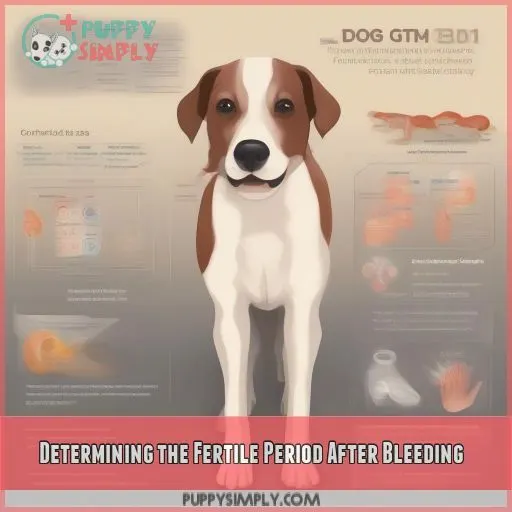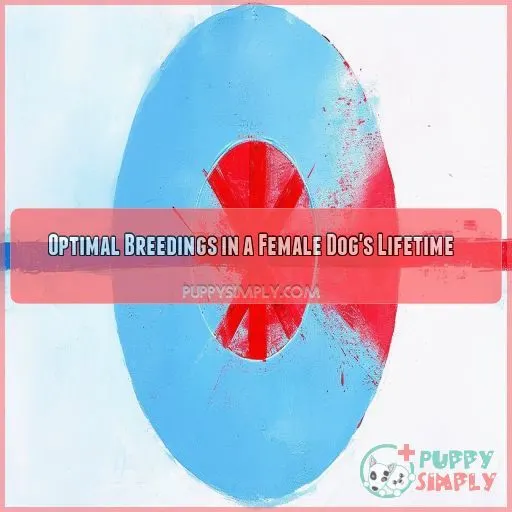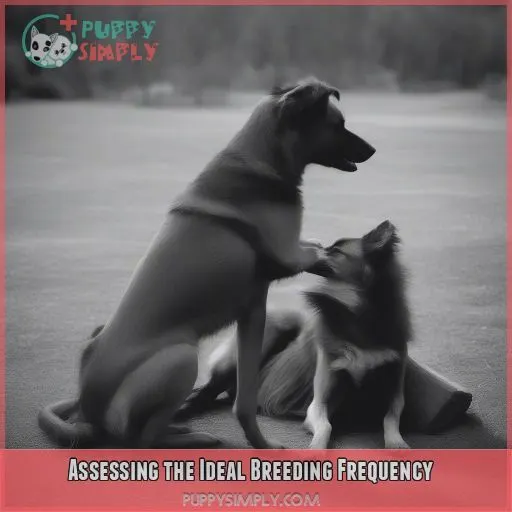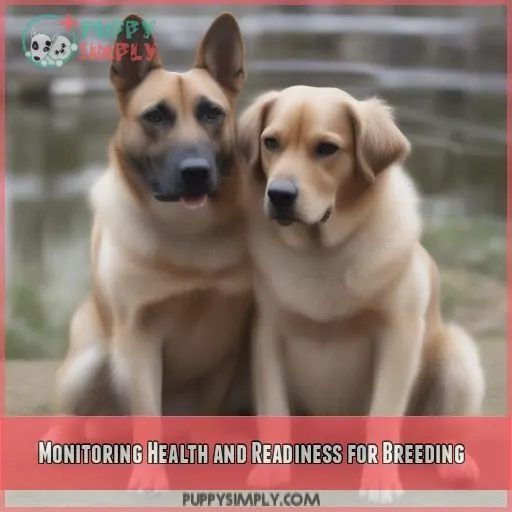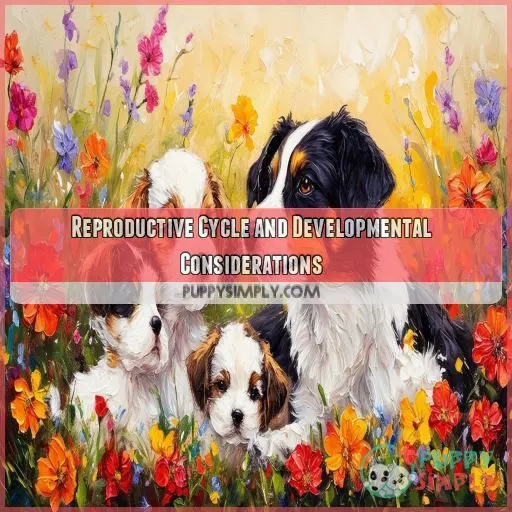This site is supported by our readers. We may earn a commission, at no cost to you, if you purchase through links.
 You’re about to embark on the exciting journey of dog breeding.
You’re about to embark on the exciting journey of dog breeding.
But first, a question: How many times does a dog need to mate to become pregnant?
Understanding canine reproductive biology is key to enhancing your breeding program and making informed decisions.
This article will guide you through the intricacies of dog mating, covering everything from the heat cycle to ideal breeding frequency, to ensure a successful pregnancy for your furry friends.
Table Of Contents
- Key Takeaways
- How Many Times Should a Dog Mate to Get Pregnant?
- How Long Does a Female Dog Stay in Estrus?
- Determining the Fertile Period After Bleeding
- Optimal Breedings in a Female Dog’s Lifetime
- Assessing the Ideal Breeding Frequency
- Monitoring Health and Readiness for Breeding
- Reproductive Cycle and Developmental Considerations
- Ensuring Successful Mating
- Understanding the Significance of a Tie
- Addressing Mismating Incidents
- Frequently Asked Questions (FAQs)
- How many times do dogs need to hook up to get pregnant?
- How many days will a female dog let a male mount her?
- How long after bleeding is a dog fertile?
- How many times should you breed a female dog in her lifetime?
- What factors determine optimal mating frequency?
- How often do dogs mate during this time?
- What health checks are key for breeding dogs?
- How can we prevent health issues in pregnant dogs?
- What are the signs a dog is ready for breeding?
- Conclusion
Key Takeaways
The ideal time to breed your dog is during its fertile window, typically days 9-10 of the estrous cycle. It is generally recommended to mate your dog 2-3 times during this period. Monitor physical changes and behavior to determine peak fertility. pre-breeding health checks and genetic testing promote health and well-being for the dog and its puppies.
How Many Times Should a Dog Mate to Get Pregnant?
Regarding the number of mating sessions necessary for a dog to conceive, there is no universal solution. It is contingent upon several variables, such as breed, health, and hereditary factors. The frequency of breeding, or how frequently a female dog mates, is crucial for successful reproduction. There is no set number, but knowledge of the estrus cycle and fertile period is essential. Typically, a female dog’s estrus cycle lasts 18–24 days, with a fertile window of approximately 9 days.
If you are contemplating breeding, continue reading for insights on optimizing the process.
How Long Does a Female Dog Stay in Estrus?
The length of time a female dog remains in estrus, or heat, varies. On average, a dog’s estrus cycle lasts about three weeks, but it can range from 18 to 24 days. This cycle is part of a larger estrous cycle, which repeats every six to seven months.
During estrus, your dog experiences significant hormonal changes, leading to behavioral shifts. She becomes more receptive to male dogs and may exhibit mating behaviors. This period is when ovulation occurs, and it’s the best time for mating.
The duration of estrus is influenced by follicle development and ovulation timing. On average, the fertile period during estrus lasts around nine days, with the peak occurring on the ninth or tenth day. This timing is very important for successful mating and pregnancy.
Determining the Fertile Period After Bleeding
Monitoring your female dog’s physical changes can help you determine when she’s ovulating and most fertile. Paying close attention to signs like vulvar swelling, increased urination, and behavioral changes will allow you to time breedings for the opportune fertility window.
Signs of Ovulation
During the fertile period, your dog will display clear signs of ovulation, indicating the ideal time for breeding. These signs include behavioral changes, such as increased receptivity to males, as well as physical changes like vaginal discharge, vulva swelling, and uterine contractions.
Monitoring Physical Changes
Once you’ve identified ovulation signs, it’s pivotal to monitor physical changes to determine the fertile period. Keep an eye on vulva swelling and vaginal discharge. Discharge monitoring is key, as it indicates mating frequency. Vaginal cytology and serum progesterone tests offer further insights. Prenatal care and dog pregnancy testing guarantee a healthy litter.
Optimal Breedings in a Female Dog’s Lifetime
Regarding breeding strategies for your female canine companion, it’s imperative to take into account timing, well-being, and overall health. While a single mating may suffice for pregnancy, responsible breeding entails meticulous planning and evaluation of various elements.
Breeding maturity is a paramount facet of a female dog’s reproductive journey. Typically, the initial breeding should transpire around the third estrus cycle, fostering physical, psychological, and emotional maturity. This waiting period is especially pertinent for larger breeds that mature at a slower pace compared to their smaller counterparts.
Conversely, it’s prudent to conclude breeding by the time your dog reaches 5 to 7 years of age. With advancing age, pregnancies pose greater challenges, and the likelihood of miscarriage, injury, or complications during gestation and delivery escalates.
Health considerations are of utmost importance. Pre-breeding health assessments, encompassing physical examinations and genetic testing, are essential measures to identify any potential issues. Maintaining optimal health conditions and prenatal supplementation guarantee that your dog is in peak condition for pregnancy.
Postpartum care is equally crucial. Following parturition, your dog will require ample rest and nutrition, while the puppies necessitate frequent feedings and a warm, hygienic environment. Vigilant monitoring of both mother and puppies for any health concerns is paramount during this sensitive period.
Assessing the Ideal Breeding Frequency
When evaluating the ideal breeding frequency for your dog, it’s essential to take into account numerous factors, including mating frequency, genetic implications, and the breeding environment.
The mating frequency of a female dog can vary based on breed and individual health. While some dogs may require only a single mating session to become pregnant, others may benefit from consecutive breedings or spaced-out matings. It’s important to observe the outcome of each breeding and adjust the frequency accordingly.
Genetic considerations play a critical role in establishing the ideal breeding frequency. Pre-breeding health evaluations and genetic testing can help identify any potential risks or hereditary diseases that may impact the litter size or the health of the mother and puppies.
The breeding environment should be clean and sanitary, with appropriate hygiene protocols in place to prevent the spread of infectious diseases. Ensuring the health and safety of the breeding dogs and their offspring is of utmost importance.
Additionally, post-mating care is essential for the well-being of the mother and her future puppies. Proper nutrition, rest, and monitoring for any signs of infection are critical aspects of successful dog breeding.
Monitoring Health and Readiness for Breeding
To confirm your dog’s preparedness for breeding, conduct thorough pre-breeding health assessments and genetic testing. These steps assist in identifying any potential health concerns and maximize the likelihood of a successful pregnancy.
Pre-breeding Health Assessments
Before breeding, it’s essential to confirm that your dog undergoes a thorough health evaluation.
This includes a physical exam to assess overall health and breeding readiness.
Veterinary recommendations for pre-breeding checkups are vital to identify potential issues and maintain optimal health for a successful pregnancy.
Health considerations are a key aspect of responsible female dog breeding. Be sure to follow veterinary advice on prenatal supplementation, post-mating care, and preventive measures to ensure a clean and sanitary breeding environment.
Genetic Testing
Genetic testing is a critical aspect of monitoring health and readiness for breeding. It provides insights into your dog’s genetic predisposition to certain hereditary diseases, enabling proactive disease prevention and management. DNA analysis helps identify potential health risks, ensuring informed breeding decisions that prioritize the dog’s well-being and contribute to breed preservation.
Reproductive Cycle and Developmental Considerations
To guarantee a successful pregnancy, you should wait until your dog reaches full physical, mental, and emotional maturity, typically by the third heat cycle. As dogs age, pregnancies carry more risks, so it’s important to balance breeding frequency and your dog’s overall health.
Maturity for Successful Pregnancy
When it comes to guaranteeing a successful pregnancy, maturity matters. Smaller breeds reach maturity more quickly than larger breeds, and it’s important to wait until your dog is physically, mentally, and emotionally mature before breeding. This typically occurs around the third heat cycle, which is when most breeders recommend starting. This reduces the risk of injury and stunted growth, guaranteeing your dog is ready to handle the demands of pregnancy and motherhood.
Breed differences play a role here, with some breeds reaching maturity faster than others. So, it’s always good to consult a veterinarian familiar with your dog’s breed to guarantee optimal health and timing for breeding.
Reducing Risks With Age
As your dog matures, it’s imperative to be aware of age-related risks and pregnancy complications. Here are some considerations for minimizing risks as your dog ages:
- Breeding frequency: Increase the time between breedings as your dog gets older. Allow for more time to recover between pregnancies to reduce the risk of complications.
- Ideal timing: While the first breeding can occur around the third heat cycle, it’s important to complete breeding by 5-7 years old to minimize potential risks.
- Health assessments: Regular health checks are essential, especially as your dog ages. Monitor their overall health and well-being to ensure they’re in good condition for a healthy pregnancy.
- Pregnancy complications: Older dogs may experience more challenging pregnancies, with an increased risk of miscarriage, injury, or other complications. Be prepared for potential challenges and have a plan in place with your veterinarian.
Ensuring Successful Mating
When breeding your dog, timing is essential. Consider whether consecutive matings or spacing out the breedings is more beneficial for your dog’s reproductive health and successful pregnancy.
Timing Considerations
Now, let’s delve into the complexities of timing considerations for successful mating.
The Estrus Cycle
The estrus cycle, or heat cycle, typically spans a duration of three weeks.
Identifying the Fertile Period
Within this cycle, the fertile period occurs during the second stage, marking the most opportune time for breeding.
Signs of Ovulation and Physical Changes
It is crucial to recognize the signs of ovulation and physical changes in the female dog to optimize mating frequency. This includes monitoring behavioral changes.
Back-to-back Breeding Vs. Space Matings
When it concerns guaranteeing successful mating, there are two schools of thought: back-to-back breeding and spaced matings. Here’s a rundown of both approaches:
Back-to-back Breeding
- This method involves mating the dogs consecutively without significant breaks.
- It’s believed to increase the chances of conception by maximizing the opportunity for fertilization.
- However, it may lead to tiredness in the male dog, potentially affecting his performance.
Spaced Matings
- Spaced matings, on the other hand, involve allowing for some time between breedings.
- This approach gives the male dog time to rest and recover, ensuring he’s energetic and enthusiastic for each mating.
- Spacing breedings can also help maintain the health and well-being of the male dog, reducing the risk of exhaustion or injury.
The decision between back-to-back breeding and spaced matings depends on various factors, including the dogs’ energy levels, age, and overall health. It’s essential to monitor the dogs’ behavior and adjust the mating frequency accordingly.
Here are some key considerations:
- Conception rates: Spaced matings may result in slightly lower conception rates, but they can help maintain the male dog’s vigor and interest.
- Litter size: While back-to-back breeding may not directly impact litter size, ensuring the male dog’s health through spaced matings can contribute to healthier puppies.
- Birth weight: Adequate spacing between breedings can positively impact puppy birth weight, as the male dog’s health and energy levels are maintained.
- Pregnancy complications: By reducing the stress on the male dog, spaced matings may help lower the chances of pregnancy complications for the female dog.
Understanding the Significance of a Tie
Understanding the Importance of Mating in Dogs
To fully grasp the significance of a tie in dog mating, it’s essential to recognize that it refers to the physical connection between two dogs during the breeding process. This natural occurrence is vital for successful fertilization.
Factors Contributing to a Successful Tie:
- Tie Strength: This pertains to the male dog’s physical capabilities and his ability to maintain the connection. A strong tie allows the male and female dogs to remain locked together for an adequate period.
- Tie Duration: The length of time the dogs remain tied together is of utmost importance. A longer duration enhances the likelihood of fertilization.
- Tie Position: The positioning of the dogs during the tie can influence the success of fertilization. The optimal position ensures proper alignment and penetration.
- Tie Behavior: The behavior of both dogs during the tie plays a crucial role. They should remain calm and relaxed to facilitate successful mating.
The importance of a tie lies in its role in achieving successful fertilization. By optimizing these factors, you can increase the chances of a healthy pregnancy and litter.
Addressing Mismating Incidents
Mismating incidents can be stressful, but there are steps to take to address them effectively. Here’s what to do:
- Mismating Prevention: Take preventive measures to avoid mismating incidents. Make certain of a clean and sanitary breeding environment, maintain proper hygiene protocols, and keep vaccinations up to date.
- Post-Mismating Care: If a mismating incident occurs, focus on providing care for the female dog. Evaluate her health, comfort, and well-being.
- Semen Evaluation: Collect and evaluate the semen from the male dog involved in the mismating incident. This can help determine the potential for pregnancy and the need for further action.
- Interfering Factors: Identify any factors that may have contributed to the mismating incident, such as environmental distractions or breeding inexperience. Address these factors to prevent future occurrences.
- Genetic Implications: Consider the genetic implications, especially if the male dog is unknown. Discuss the potential risks with a veterinarian.
Frequently Asked Questions (FAQs)
How many times do dogs need to hook up to get pregnant?
It’s recommended to mate dogs 2-3 times over 6 days during the female’s fertile window, which is typically days 7-10 of her estrous cycle.
How many days will a female dog let a male mount her?
How long do you think a female dog will let a male mount her? Well, it’s usually for a period of two or three matings, every other day, on days 9, 11, and 13 of the cycle.
How long after bleeding is a dog fertile?
Bleeding is a sign that a dog is about to become fertile. After around 9-10 days, the bleeding will become more watery or stop, which is when the dog is most likely to be at its most fertile.
How many times should you breed a female dog in her lifetime?
It’s a tough journey for a dog, from breeding to delivery. Give your dog time to heal. Allow at least one heat cycle between breedings. Start after her third cycle and end before she’s five to seven.
What factors determine optimal mating frequency?
Appropriate mating frequency relies on breed characteristics, reproductive health assessments, timing, and monitoring. Breed size, maturity, and fertility rates vary, influencing mating schedules. Timing mating during the estrus cycle and spacing out matings aid reproductive health.
How often do dogs mate during this time?
During the fertile window, mating can occur every other day or with spacing in between. The most favorable mating day is the 9th or 10th day of the estrus cycle.
What health checks are key for breeding dogs?
Pre-breeding health checks are key. Take your dog for a general check-up to confirm they’re up to date with vaccinations, worming, and flea and tick treatments. Also, consider genetic testing to understand the health risks they may pass on to their puppies.
How can we prevent health issues in pregnant dogs?
For a healthy pregnancy, provide a calm, indoor environment with regular short walks and light playtime. Guarantee access to plenty of water and feed premium adult food with extra nutrition. Deworming is essential to prevent worms in puppies.
What are the signs a dog is ready for breeding?
Your dog will exhibit behavioral changes, like aggression or clinginess, and physical changes, like a swollen vulva and frequent urination. Testing can also confirm breeding readiness.
Conclusion
As a dedicated dog breeder, understanding the intricacies of canine reproduction is key to your success.
This guide has equipped you with the knowledge to navigate the heat cycle, optimize breeding frequency, and facilitate healthy pregnancies for your furry companions.
Now you know how many times a dog should mate to become pregnant, you can guarantee the health and safety of your dogs and their litters.


